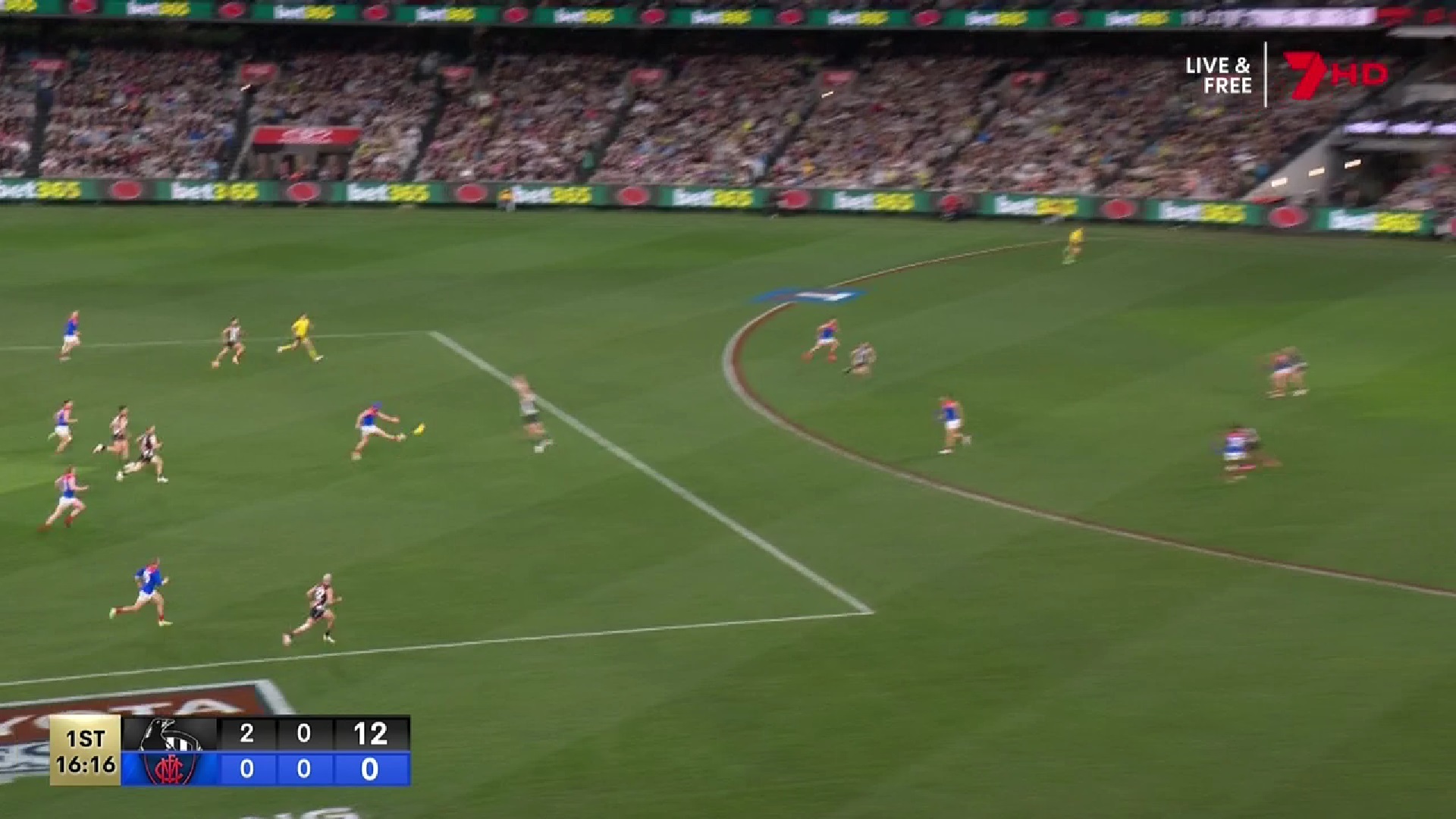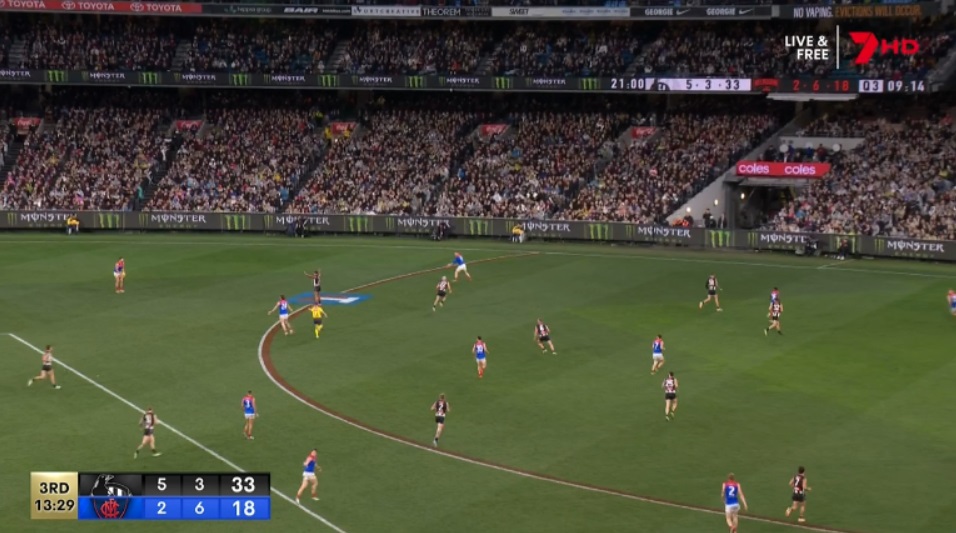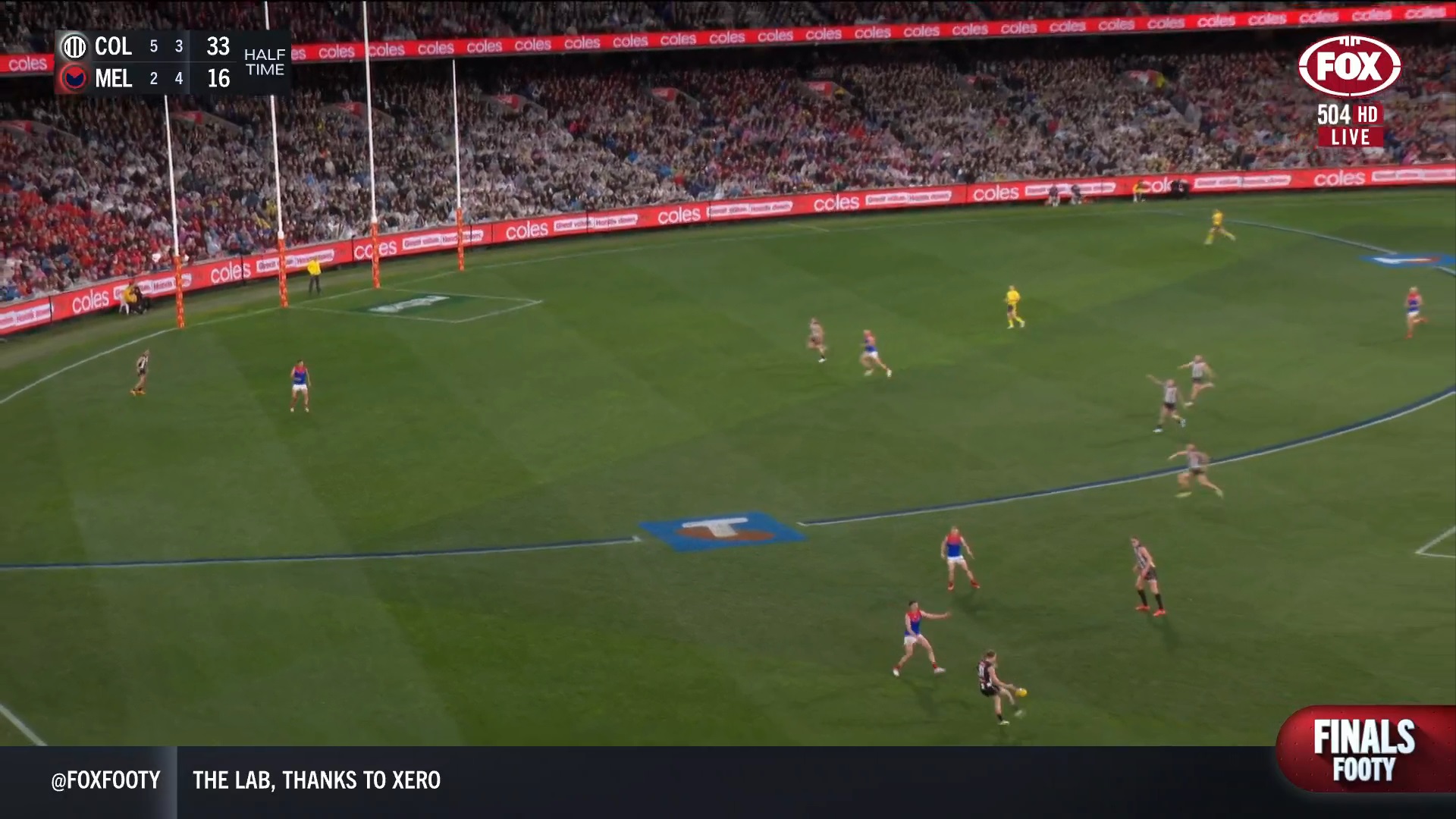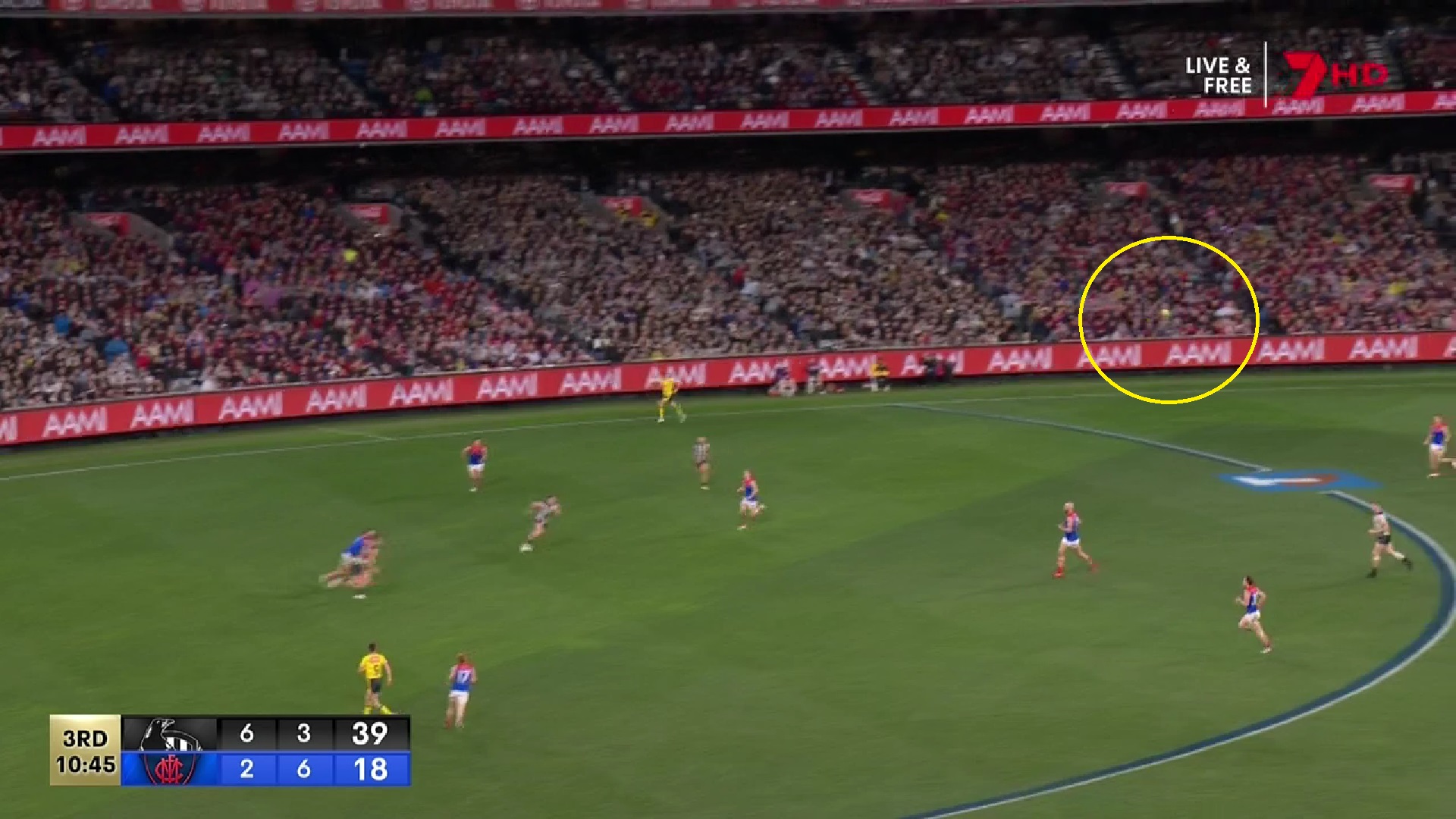There are two major storylines out of Thursday night’s qualifying final at the MCG – and both are equally compelling.
The first is Collingwood, and in how, having been seemingly teetering on finals eve with concerns over their contested ball-winning and their defence, executed both to an exemplary degree to at least match and largely overwhelm a Melbourne team with key strengths in both. That the margin was only seven points at the end doesn’t really tell the complete story.
It might be far from the most spectacular performance of Craig McRae’s tenure – there was no hair-raising final quarter comeback nor wave after wave of sensational team goals – but it’s without question the most significant yet. Given the circumstances, given the conditions, and most of all given their best player and biggest weapon was sitting on the sidelines watching it all unfold, this was a performance superb enough to rubber-stamp the Pies as not just flag favourites, but with one hand on the cup itself.
The second story is Brayden Maynard, and the mid-smother bump on Angus Brayshaw that both ensured a key piece of the Demons’ puzzle will miss their sudden-death semi-final against Carlton or Sydney next Friday, and – God forbid – whatever long term concussion symptoms the footy gods in their cruelty see fit to bestow on a young man with a history of head knocks.
I imagine Pies fans will love me for my thoughts on the first and despise me for my take on the second – so let’s start with how this match was played, won… and lost.
At every quarter break of this match, the most fascinating stat – and an example of why every piece of data needs context or its worthless – was the inside 50 count.
After the Magpies blitzed the Dees with a white-hot start for the first six of them, bagging two goals, the Dees would only trail 15-13 at quarter time. They’d have a staggering 20 to eight in the second quarter, and then 17 to 10 in the third quarter. Then the last, a 19-4 Demons advantage.
All up, it was 37 inside 50s to 69. Yep. SIXTY-NINE. (Nice.)
It’s a territory dominance you rarely see in a final – even West Coast didn’t lose the count that comprehensively all that much this year.
The problem is that to suggest inside 50s mean anything is to take with it the implication that all inside 50s are equal – which they very clearly are not. Collingwood play in such a way that even a single entry is deadly and every repeat shot brings with it less and less chance of escape. Melbourne… don’t.
I can’t remember a team in a final deliver the ball worst inside 50 than the Demons did; both in a first half and specifically second quarter that prevented them from capitalising on the first and only true period of ascendancy all evening, and then after ‘changing some of the way we enter the ball with our kicking’ at half time, according to an interview with Seven by Simon Goodwin.
It started with their very first inside 50 of the night – the one Brayshaw got clobbered on. Yes, they got a goal virtue of the downfield free kick, but all that did was highlight just how unnecessary Maynard’s action was.
Here is a shot of the 50 Brayshaw was kicking into.

Over the back, where the ball lands, Bayley Fritsch is one-on-one with the much bigger Darcy Moore, while out of the goalsquare Jacob van Rooyen runs to the contest with Nathan Murphy for company.
There’s a couple of issues here, both in the delivery and the actual set-up. For one thing, Brayshaw banging it long from that spot, having made the sort of centre clearance breakaway that 6-6-6 rules have turned into a monstrous threat, is exactly what the Magpies want you to do. It’s why Maynard runs so hard at the ball-carrier, to both pressure and ensure the kick can’t be directly scored from.
The major problem, though, is one I’ve harped on about with Melbourne for more than 12 months: who’s leading for the ball?
Because of the way the Demons structure, they have three forwards on the edge of the arc looking to push up and become part of the play, two – usually Fritsch and van Rooyen – deep in the goalsquare, and one – often Joel Smith – as the midway man.
Here the issue is Smith: with Howe for company, a noted aerialist but who can be vulnerable against leading forwards, Smith should be presenting for the ball and demanding that footy the moment he sees Brayshaw charging out. Even if that means he marks on or outside 50, it opens up that midway space for him, giving ample paths for Fritsch and van Rooyen to lead into. It’s forward craft 101.
Brayshaw, in all honesty, should be dinking over the top to Christian Petracca, Maynard’s free opponent, anyway. Or, if he’s braver, the wider ball to Alex Neal-Bullen running back towards goal, with his opponent Oleg Markov sensing the Petracca danger and going towards him.
Either way, the Dees had a sizeable advantage in this position, and but for Maynard taking out Brayshaw they’d have most likely squandered it.
This was the sum of the Demons’ entries throughout the game, and was both the reason why they found themselves nearly five goals down early in the second half and why dominating the last quarter in every facet could only bring them three further goals.
There are some examples of where it’s simply poor kicking inside 50: this Clayton Oliver entry, ignoring leads from Fritsch and Tom McDonald and bombing it long to where Darcy Cameron has set up as a free ruckman behind the play is about as dumb as things got.
 There’s also this silliness from Ed Langdon: yes, he’s under pressure, but Jack Viney is free five metres ahead of him for a handball and he’s kicking to a three on one, AND, and this is key, not a single Demon is leading up to the ball until after it’s kicked. The lack of cohesion is alarming.
There’s also this silliness from Ed Langdon: yes, he’s under pressure, but Jack Viney is free five metres ahead of him for a handball and he’s kicking to a three on one, AND, and this is key, not a single Demon is leading up to the ball until after it’s kicked. The lack of cohesion is alarming.

There are also structural problems: when Steven May bulleted a pass across the ground to Smith at half-forward, the Dees had the chance of attacking the Pies’ defensive 50 on the far side.
If Smith and Neal-Bullen are alert to it, there’s a spot just behind the umpire, free of Magpies defenders, to lead into. It’s what the Magpies, and Brisbane too, do so well going the other way.
Instead, Smith holds the ball, holds it some more, then gives a short pass to Trent Rivers sideways, who looks to bomb it long… and gets it smothered. I’m not even sure it ever went inside the 50.
You get away with stuff like this against bad, or even mediocre, teams. For Collingwood, it’s manna from heaven: a chance to load back their famous slingshot, get numbers behind the ball, and then the instant they win it back, explode.

Even in the last quarter, where they started to give themselves more scoreboard impact, not much changed: the Dees still banged the ball long and haphazardly into attack, it’s just that the Magpies, presumably knackered, began to make mistakes.

The above entry, from Petracca, is nothing special: it’s long to an even-numbered contest, the kind of ball the Magpies’ army of interceptors have hoovered up all game. Just this time, Isaac Quaynor fumbles and lets the ball out the back, and then from the resultant chaos ball, Maynard misses a tackle and then overcommits from the smother to let Tom McDonald goal from close range.
It’s with this sort of kicking that you can have 19 inside 50s against a flagging defence and still only have five scoring shots, and only kick three goals. The final major, set up by Petracca, was the one decent kick in there all night, and even then it only worked because for the only time all night, Darcy Moore was forced to defend in a one-on-one.
In short, the Demons are far too predictable going inside 50 – and even before tonight, this year they’ve scored from just 41 per cent of their inside 50s, ranked 14th in the AFL. It’s far from a one-off.
The Pies knew they’d go long all night, and set up accordingly. They knew with pressure on the ball-carrier, of the kind they executed brilliantly all evening, would mean panicked long balls that might not lead to swathes of intercept marks, but would give them numbers aplenty at ground level to at worst neutralise and force stoppages, and at best… begin their own assault.
The Pies, meanwhile, are nothing if not chaotic going into their own attack: it’s impossible for a defence even as good as Melbourne’s to predict. This Beau McCreery kick is a great example: he has three options to go inboard, and yet he chooses to deftly snap around the corner for Jack Crisp to run onto. What defender could possibly have expected him to go there?

Another great one came from Patrick Lipinski in the third term: here’s the shot of the Demons’ defence as he kicks it.

It’s a good set-up for a high ball: Gawn is in the hole ready to intercept, May and Lever are both in their usual zones, and there are no loose Pies players ahead.
But Lipinski lowers his eyes, and the kick inside is magnificent: it draws Daniel McStay like a magnet to the footy, into the space over Gawn and in front of May.

It’s this precise kick that makes Collingwood so lethal moving the ball in transition: not only does the pace of their ball movement from half-back create open pockets and deny teams the chance to stack numbers into their defensive 50, as the Pies themselves did all night, but the cohesion between their midfielders and forwards is almost telepathic.
You might look at this game and think the Dees lost it with just seven goals from their 69 entries. But for Collingwood to muster a winning score – even a small one – from 37 of their own is down as much to their defensive stinginess and Melbourne’s poor entries as it is the reverse going their own way.
That’s why they’re into a preliminary final. That’s why they’re premiership favourites.
Now that that’s done, here’s the second talking point: Brayden Maynard should get two weeks for his bump on Brayshaw.
Is it an accident? Absolutely. 100 per cent. For all the social media sniping at Maynard over the way he plays and his history of incidents – though none anywhere near as serious as this one – there’s no way he left the ground with the intent to knock Brayshaw into next week, nor to connect his shoulder with the Demon’s head.
Was it a footy act? Again, yes: he’s attempting to smother the ball. This isn’t an off-the-ball gut punch or other unnecessary dog act.
But all the above does, in my honest view, is take it down to two weeks rather than three, four or five. I argued the same ban should apply to Rhyan Mansell for his bump on James Aish earlier this year, a similarly accidental footy act with equally nasty consequences.
For me, this is an identical incident to Patrick Cripps knocking out Callum Ah Chee last year, for which he was initially suspended for two weeks and then reprieved by an AFL Appeals Board overrule that was, to put it mildly, controversial.
Here’s what I wrote about the Cripps case after it was overturned:
“The Blues’ successful defence carried with it the standing that as long as the ball is there to be contested, anything goes.
“And my argument is that in this case, Cripps’ attempt to contest the ball made serious injury – and yes, a concussion is a serious injury – likely if not inevitable.”
If Maynard is going to put himself into a position to cause injury to another player – and like Cripps, he does this by leaving the ground and flying into an oncoming player at speed and with shoulder extended – then he is culpable for any injury that does occur. And as we’ve seen time and time again with the MRO these days, concussion is nearly always cause for a ban.
Concussion is also such a significant issue in the game – just look at the Seven ads throughout the game for an upcoming story on the great John Platten’s battle following repeat head knocks – that it requires the AFL to mandate players change the way they approach attacking the footy.
What Maynard did hasn’t been illegal for 120 years of footy, but nor was sliding in until Gary Rohan broke his leg a decade ago. Times change.
The issue is that the Magpies will do as Carlton did for Cripps, and fight it: in all honesty, for all the talk the AFL closed the Cripps loophole after last year’s fiasco, he’ll probably get off.
But that doesn’t mean Michael Christian still doesn’t have a duty to grade Maynard’s contact as careless conduct, high impact, and high contact. That brings with it two weeks, and a grand final missed – until the Pies challenge at the Tribunal and the AFL Appeals Board, and inevitably, find a loophole in the rules or adjudication of a system unfit for purpose and get him off the charge.






























































































 There’s also this silliness from Ed Langdon: yes, he’s under pressure, but Jack Viney is free five metres ahead of him for a handball and he’s kicking to a three on one, AND, and this is key, not a single Demon is leading up to the ball until after it’s kicked. The lack of cohesion is alarming.
There’s also this silliness from Ed Langdon: yes, he’s under pressure, but Jack Viney is free five metres ahead of him for a handball and he’s kicking to a three on one, AND, and this is key, not a single Demon is leading up to the ball until after it’s kicked. The lack of cohesion is alarming.




